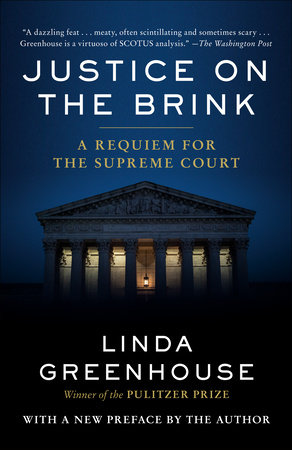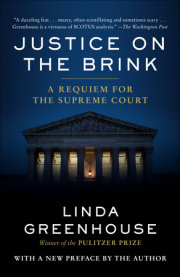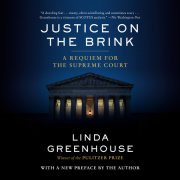Chapter one
July • The Triumph of John RobertsJust as baseball fans relish statistics, so do Supreme Court watchers: how often a justice votes with the majority, how often in dissent, how often allied with this colleague or that one. With the numbers, a portrait takes shape to reveal a justice’s power and role on the court. For Chief Justice Roberts, the portrait that emerged from the term that ended on July 9, 2020, was one of triumph.
Of the term’s fifty-three cases decided with signed opinions—an unusually low number, due to the postponement of cases scheduled for argument early in the shutdown—he was in dissent in only two, fewer than any of his colleagues and his own record low for his fifteen years on the court. The easiest way to keep track of the court during the term’s nine months was simply to look for John Roberts, finding him in the majority in decisions on presidential immunity, immigration policy, religion, abortion, protections for LGBT employees, and nearly everything else.
He managed at crucial moments to navigate across the court’s ideological divide. He maintained the court’s focus when the pandemic drove the justices from their chambers and their courtroom, leaving them to hear cases not on a fancy Internet platform but over their home telephones. And as important as anything else was this: Under a hot election-year spotlight, he kept the Supreme Court out of trouble. After the court handed down its last decisions on July 9, two weeks later than usual, he was entitled to feel both relief and pride.
It might so easily have been otherwise, as he surely knew. Had the 2016 presidential election turned out as most people expected, a President Hillary Clinton would have filled the Scalia vacancy, and Roberts would have found himself facing the prospect of near irrelevance. Ruth Bader Ginsburg, as the senior justice among five liberals on the court, would have been able to shape the course of events, leaving the chief justice a bystander.
Of course, not every Supreme Court case turns on ideology. Most do not; during the term that included the 2016 election, the court decided more than half its cases unanimously. But when ideology matters, it matters greatly. The loss of a reliable conservative majority would have doomed two projects on which Roberts, with Scalia as a reliable ally, was making steady progress. Those two projects lay at the center of the national conversation, indeed at the heart of the country’s struggle to define itself during the opening decades of the twenty-first century. One involved race, the other religion. Roberts’s long-term plan was to change how the Constitution understood both, and now, with Donald Trump having filled the Scalia and Kennedy vacancies, he was in a position to achieve his goal.
There had not been a case concerning racial equality on the docket for the 2019–20 term, but that was an anomaly—a fortunate one for any chief justice interested in his court’s keeping a low profile, given the urgent racial reckoning that shook the country following the police killing of George Floyd, an unarmed Black man, in Minneapolis on May 25. Race would certainly be back, and Roberts was ready, even though he might not have been aware that an important new Voting Rights Act case had arrived at the court in April, filed by Arizona Republicans seeking to limit the use of the Voting Rights Act of 1965 to attack measures that result in suppressing the vote. It would be early fall before the petition made its way to the justices for action.
The debate over public policy concerning race—voting rights and affirmative action, to which he referred, dismissively, as “racial balancing”—had drawn Roberts’s interest since his earliest days as a lawyer. In 1981, direct from a Supreme Court clerkship, he had joined the Reagan administration, where he was an eager participant in the administration’s program to dismantle or at least curtail race-conscious policies across the government and in the private sector as well. Serving first as a special assistant to Attorney General William French Smith and later as a lawyer in the White House counsel’s office, he wrote strongly worded memos marshaling opposition to efforts under way in Congress to renew an expiring section of the 1965 Voting Rights Act and to restore another section that a 1980 Supreme Court decision had undercut. These internal memos came to light in 2005 when President George W. Bush nominated Roberts to be chief justice, and they provided what little substance there was to the Democrats’ tepid opposition to his confirmation.
On becoming chief justice, John Roberts had moved quickly to convert his long-held views into law. A case known by the shorthand Parents Involved reached the court during his first term and presented just such an opportunity. Formerly segregated public school systems in Louisville and Seattle had emerged from years of federal court supervision after achieving what the courts deemed an acceptable level of racial integration. Each city was determined to protect that hard-won accomplishment from the demographic pressures of resegregation driven largely by housing patterns. Each had adopted student assignment plans that took a child’s race into account in considering a request to attend or transfer to a particular school; if an application threatened to upset a school’s racial mix, it would be denied. In each city, white parents whose requests had been denied brought a lawsuit claiming that their children were victims of racial discrimination.
These were not the first such lawsuits. All had failed, the lower courts accepting the argument that plans like these were justified as a way to prevent backsliding into racial isolation. Ordinarily, the Supreme Court agrees to hear only those cases that reflect disagreement among the lower courts, on the premise that only the Supreme Court can resolve a “conflict in the circuits” and provide a binding national rule. Despite the conspicuous absence of a conflict, the justices agreed to hear the appeals from the Louisville and Seattle parents, consolidating them for a single argument during the 2006–07 term on whether, even for the purpose of preserving integration, the overt consideration of race violated the Constitution’s guarantee of equal protection. The court’s answer, overturning two federal appeals courts, was that it did. The vote was 5 to 4.
Roberts assigned himself the majority opinion. Explaining why the student assignment plans were unconstitutional, he wrote that the school systems’ interest in avoiding resegregation was not sufficiently “compelling” to justify a racially conscious remedy. The court’s equal protection precedents provided that only a “compelling interest” could excuse a government policy that took race into account. To proclaim that a formerly segregated school system had no compelling interest in avoiding a return to racial isolation was a bold move, further than Roberts needed to go to justify his position. The court’s precedents require that in addition to serving a compelling interest, a race-conscious policy must also be “narrowly tailored,” that is, it can be no broader than necessary to accomplish the purpose. A government body that fails the narrow tailoring test can go back to the drawing board to achieve its goal by other means. But a finding of “no compelling interest” means that the goal itself is illegitimate.
Three of the conservative justices who had cast their votes with Roberts at the justices’ private conference signed his opinion, but the fourth, Anthony Kennedy, refused. Of course “a compelling interest exists in avoiding racial isolation,” Kennedy declared in his separate opinion. His view was that the case presented simply a narrow tailoring problem: The school systems should be required to try alternatives, such as redrawing school attendance zones, that did not require taking an individual student’s race into account.
Roberts’s refusal to concede the legitimacy of the school systems’ goal had driven away a natural ally, a justice who in two decades on the court had never upheld a government policy that counted people by race. In losing Kennedy, he gave up the chance to speak for a majority; he “lost the court,” as the expression goes when a justice starts out writing a majority opinion but ends up falling short. True, the court had invalidated the challenged assignment plans, but it did so in a way that failed to clarify, much less change, the law.
The mystery was why Roberts behaved as he had. Was he simply determined, no matter the cost, to lay down a marker for what he had long believed, that the government should basically get out of the race business? Or did he misjudge the dynamic of a court that he had known well as an advocate but where he was still a newcomer as a justice?
Copyright © 2021 by Linda Greenhouse. All rights reserved. No part of this excerpt may be reproduced or reprinted without permission in writing from the publisher.








